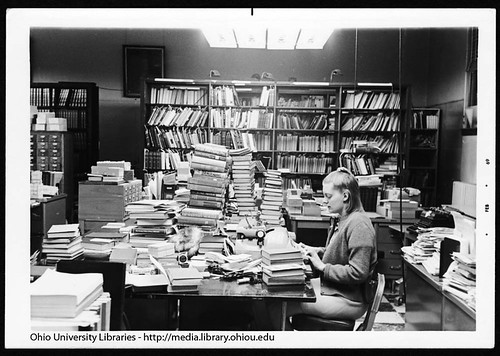Cataloging on the edge
March 23rd, 2014 at 9:28 am (Education, Library School)
The first major assignment for my Cataloging class was to round up 20 books and create catalog entries for them. Any books, so long as no more than three were “literature.” After getting stuck for a while on trying to decide what exactly “literature” was, I settled on my books (mostly non-fiction, which apparently was the goal), and dove in.

This was hard.
This was hard because there are no good resources out there (that I know of, or that my class knows of) for exactly how to “catalog a book.” This astonished me, since a system that allows many many people to contribute data is exquisitely vulnerable to any inconsistencies in how those records are created. Surely there are standard rules for what information to include, where to find it, and how to express it?
Kind of.
The currently cataloging ruleset, RDA (Resource Description and Access), sets forth guidelines about what kind of content should go into a bibliographic record, but not how to format it. RDA seeks to implement FRBR (Functional Requirements for Bibliographic Records), which is a statement of cataloging philosophy and what user needs are out there. FRBR also contains an entity-relationship diagram that traces out how works, creators, and subjects are (or should be?) connected. FRBR is silent on how to actually create a record, though.

Further, no real system out there actually implements FRBR yet, and even RDA only spells out a partial path to it (parts of RDA are not yet defined, like what kind of relationships between subjects should be captured).
In the meantime, real systems use something called MARC (MAchine-Readable Cataloging) to encode bibliographic records. So that’s what we used to catalog our 20 books. MARC provides some guidelines about formatting (e.g., when to end a field with a period and what field separators to use) but is silent on other aspects like capitalization and bigger questions like where to get the required information from. For example, how do you go about extracting the publication date from a book? How should you express the author’s name?
Here’s where the assignment gets pedagogically interesting, for two reasons.
First, we were operating at the “pleasantly frustrating” level. James Paul Gee listed this as an effectively learning principle in his guide to “Good Video Games and Good Learning.” He suggested that a good learning challenge stays within, but at the edge of, the student’s “regime of competence.” We weren’t just executing a set of well understood rules; instead, there is a lot of ambiguity and nuance, and each question pushed us to dig deeper.
Second, we were working with books in the wild. I gather that most cataloging professors assign their students the same set of books to practice cataloging on. The real answer is known, any questions or gotchas have already been anticipated, and the result is a controlled, sandbox experience.
My professor instead flung the doors wide open and let us each pick our own 20 books, without any sense of what would turn out to be easy or hard to catalog. The result was a chaotic, challenging, and ultimately far more educational experience.
This approach only worked because we had a discussion forum and a professor who monitored it assiduously. Students plastered the forum with questions. “What if the book is a translation?” “What if the pages aren’t numbered?” “What if there are multiple publishers?” Our professor responded quickly to every question, and over time I realized that I was quite possibly learning more from the forum than from my own small set of 20 books. With 88 students, we had something like 1700 books being catalogued (some are duplicates), and the array of issues that came up was dazzling. It was great to have the practice of actually creating my own records (and hunting down resources to allow me to deal with my books’ issues), but it was also fantastic to get to eavesdrop on my classmates’ questions and learn vicariously through them.
In that assignment, we only had to create fields for each book’s title, publisher, publication date, etc. The next assignment had us add the authorized form of the author’s name, and we are just about to revisit our records again to add appropriate subject headings. Each iteration makes our records richer and increases our understanding of the cataloging process. And I have to applaud Prof. Mary Bolin for structuring the process in such an interesting and valuable way.